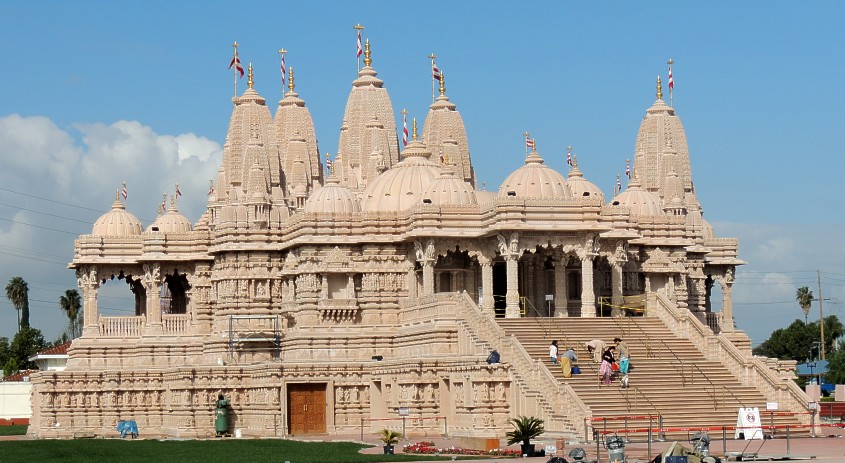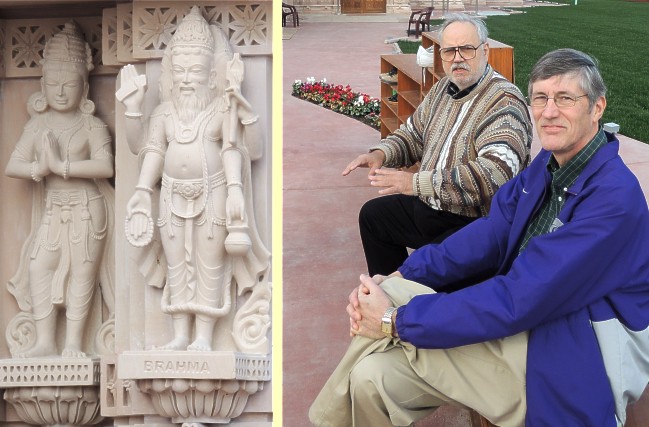Kansas Snapshots by Gloria Freeland - Mar. 15, 2013
"Outside the box"
As we got closer to Chino Hills, we could see a large structure looming in the distance. I could make
out what appeared to be domes and spires.
"I wonder what it is?" I said to husband Art. "It almost looks like a big castle."
He suggested it was perhaps an amusement park.
We had flown to California in February to help celebrate Uncle Stan's 90th birthday. We arrived about
9 p.m. at the John Wayne Airport in Santa Ana, picked up a car and headed for our hotel. In the dark,
neither of us could tell exactly what we were looking at. As we got closer, the features became larger,
but what it was remained a mystery.
The next day, Uncle Stan and Aunt Kay told us it was a Hindu temple, adding that a friend had taken
a tour and had described it as "one of the most beautiful things" he had ever seen. Stan added that
their friend wasn't the type to say such things.
Art checked the temple's website to see if a tour was possible and if so, what were the hours and
other restrictions. Visits were welcomed and other than a few hours each day, the only limitations
were a prohibition against shorts, sleeveless tops or skirts shorter than knee length. Shoes or taking
photos were not allowed inside. A sari would be supplied if needed.
We decided if it was convenient, we'd drop by for a visit.
We spent the first three days celebrating Stan's birthday with various family members and friends.
But we had some free time to do a little bit of sightseeing on Sunday while Stan and Kay were at
church. So brother Dave, who had arrived a couple of days after we did, Art and I headed off to the
temple grounds. None of us had ever been to a Hindu temple and had little idea what to expect. Of
course Art, being Art, spent some time on the Internet reading about Hinduism and what this particular
sect believed.
The temple, which opened just this past December, while eye-catching from the road, was much more
impressive as we approached on foot. The exterior sandstone produced a pink glow, and its towers shone
in the morning light. Women in saris were polishing the steps by hand using cloths.
We sat on the benches provided and removed our shoes. The marble felt cool through my socks.
Inside, we heard a soft, low chanting. Most of what we saw was white marble, although here and there
wood and gemstones provided a contrast. All had intricately-carved figures or patterns.
A man greeted us and briefly served as our tour guide, explaining a bit about the temple, the
surrounding complex of buildings and the Hindu faith. He explained that the interior was Italian
Carrara marble that had been quarried in pieces, shipped to India and was then hand-carved by
artisans. The exterior sandstone was from India. It, too, was hand-carved by Indian artisans using
hammers and chisels.
Once completed, the marble and sandstone pieces were identified with a series of numbers and
letters, packed into containers, and shipped to the port in Long Beach, Calif. From there, they
were trucked to the Chino Hills site.
An unusual feature of this particular temple is that it is supported by 40 "base isolators" -
each formed by two steel plates with a spring between them. They isolate the temple from the
foundation. In the event of an earthquake, the isolators allow for as much as 27 inches of
lateral movement.
The temple includes two domes, five pinnacles, four balconies, 122 pillars, 129 archways and
more than 6,000 hand-carved images. A parking facility on the far northern edge of the
complex is covered in solar cells that provided much of the electrical energy needed. In
addition to the temple, the complex included a meeting facility, a cultural center and a
recreation building, complete with a gymnasium. The latter two help the youngsters of temple
members remain acquainted with the history and culture of their people and still
blend into the U.S. culture.
The full name of the temple is the BAPS Shri Swaminarayan Mandir. Derived from the Sanskrit
word Mandira, a Mandir is a traditional Hindu house of prayer. Among the virtues the Hindu
faith extolls are forgiveness, honesty, unity, friendship, humility, tolerance, patience,
sacrifice and charity. The Swaminarayan faith, also known as Bochasanwasi Shri Akshar
Purushottam Swaminarayan Sanstha (BAPS) was founded just over 100 years ago in India and claims
to have more than 3,300 centers worldwide.
More than a decade in the making, the 20-acre seven-building Mandir and cultural center
complex was not without controversy. Citizens had concerns about the visual impact of the
complex, the height of the spires, traffic patterns, city priorities and whether the city
supported immigrant communities.
But now that it has been built, it is seen not just as a spiritual center, but as a place
where those of other faiths can learn and where tourists can marvel at the blend of
state-of-the-art engineering and ancient techniques that went into its construction.
Dave, who often says he tries to stay well within his comfort zone of familiar places
and customs, described it as an "outside the box" experience. Art and I agreed. The serendipity
of seeing the temple and then later visiting it became one of the many highlights of our trip.

